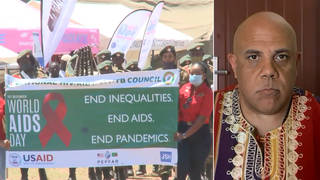
Topics
Guests
- Rick HindLegislative Director of Greenpeace’s Toxics Campaign.
- Ann LeagueVice President of Save Our Cumberland Mountains, a 36-year-old grassroots organization based in Tennessee.
- Anne PaineEnvironmental reporter for The Tennessean.
Parts of Tennessee remain buried under toxic sludge today after a major disaster at a coal plant. A forty-acre pond containing toxic coal ash has collapsed, spilling out millions of gallons of coal ash. Environmentalists say the spill is more than thirty times larger than the Exxon Valdez, but the story has received little national attention. Greenpeace is calling for a criminal investigation. [includes rush transcript]
Transcript
AMY GOODMAN: Greenpeace is calling for a criminal investigation into a major environmental disaster at a coal plant outside Knoxville, Tennessee. Early Monday morning, a forty-acre pond containing toxic coal ash collapsed. 2.6 million cubic yards of coal ash spilled out of the retention pond, burying homes and roads. Over 400 acres of land are now under as much as six feet of sludge. Environmentalists say the spill is more than thirty times larger than the Exxon Valdez oil spill.
The sludge has flowed into the Emory River, a tributary of the Tennessee River, which provides drinking water to millions of people downstream in Tennessee, Alabama and Kentucky.
Environmentalists say the disaster could take months, if not years, to clean up. The Environmental Protection Agency staff member has arrived at the scene to test the ash for toxic metals and mercury, a neurotoxin that concentrates in coal ash. Greenpeace warned that coal ash typically contains high concentrations of toxic chemicals like mercury, cadmium and other heavy metals.
The coal plant and retention pond are both operated by the Tennessee Valley Authority. Authority spokesperson Gil Francis talked to reporters Tuesday.
GIL FRANCIS: The ash pond is approximately forty acres. It’s an area where once the coal is burned, you stack the ash in a pond. And we’ve had about five inches of rain. We think that perhaps the rain and the freezing temperatures may be a contributing factor to the ash pond slide.
REPORTER: What is that dike made out of, and when was it last checked?
GIL FRANCIS: It’s an engineering constructed pond that you take the ash from the plant once the coal has been burned, and you stack it in a pond. And that’s what we did. And apparently the dike that was there failed, and as a result, there was an ash slide, like a mudslide.
REPORTER: Has it been checked recently?
GIL FRANCIS: Yes, it’s checked periodically. There is a schedule of inspections that are being done. I’ll have to get you the exact time it was checked last, but it is checked regularly.
AMY GOODMAN: We’re joined now by three guests. Anne Paine is the environmental reporter for The Tennessean newspaper. Ann League is vice president of the group Save Our Cumberland Mountains. And Rick Hind is the legislative director of Greenpeace’s toxic campaign.
I want to begin with Anne Paine of The Tennessean. Can you just lay out the scope of what you understand has taken place?
ANNE PAINE: Well, as said earlier, we’ve got hundreds of acres that are now covered with several feet of this ash sludge. Part has gone into the river. Homes have been damaged. It’s really — it’s not a large residential area, so the number of homes is limited to about twelve. But other people live in the area around this ashy wasteland at this point, and we’re waiting to see if rains are going to come in and push more of the ash into the river. Some of it’s gone in, but only a part of it at this point.
AMY GOODMAN: Anne Paine, can you locate this area for us? I think people are so geographically challenged in this country, they may not even quite even understand where Tennessee is. But locate Tennessee for us, and then within Tennessee, where this has taken place.
ANNE PAINE: Tennessee is in the mid-South between Kentucky and Alabama and Georgia. And this ash pond is in the eastern side of Tennessee. Tennessee is a long, narrow state, and it’s in the far east, which is over in the direction of the Great Smoky Mountains. And this is near a town called Harriman. It’s along I-40 West, right fifty miles west of Knoxville. And it’s very well known around here, because there are extremely tall smokestacks for the Kingston coal-fired plant there, which was using this ash pit.
AMY GOODMAN: And explain who is the Tennessee Valley Authority.
ANNE PAINE: The Tennessee Valley Authority was formed back in the 1930s during the Depression as part of Franklin Roosevelt’s New Deal. And the area was in total poverty, and TVA was formed to improve the quality of life for people, to bring electricity to the Tennessee Valley, and it did a very good job of that. It put on electric lights. It did bring jobs. It helped put Tennessee on the road to prosperity.
AMY GOODMAN: Ann League, can you talk about the whole area? You’re with the group Save Our Cumberland Mountains. But we have heard very little about this major spill. How could it be that something that — what groups are saying is more than thirty times the size of the Exxon Valdez oil spill is hardly getting any attention in this country?
ANN LEAGUE: Well, it just goes to show, being part of Appalachia, we have a history of all the catastrophes that happen here not getting a lot of attention. It is such a rural area, and there weren’t any people injured or killed, thank God. We’re not getting a lot of attention. But it’s just like, there was a huge spill in Martin County, Kentucky in 2000 that was barely even covered. There was the huge flood in Buffalo Creek in ’72 that killed 125 people, and that — you know, people don’t remember these things. This is such a rural community that we don’t get a lot of interest.
It is a beautiful community. The area around Harriman is known for its fishing. The river there is one of the cleanest in the area. People go down there to recreate, to fish. It’s just a huge, huge problem that this has happened. I mean, this is affecting more than the people who just live around there; this affects everyone in the area. And it just shows that the cycle of coal can never be clean.
AMY GOODMAN: I want to go to Rick Hind now, legislative director of Greenpeace’s toxic campaign, joining us from Washington, D.C. Can you explain the content of the coal — of the ash? Could this have been predicted? Explain the history in Tennessee that has led up to this week’s horrible spill.
RICK HIND: Well, this coal plant is over fifty years old, and it has several of these ponds that contain the coal ash, which is really just unburned coal that is brought over from the smokestacks that you described. It’s an inevitable part of the coal burning technology, which is polluting from beginning to end, from the mountaintopping we see to clear whole mountains away to bring the coal to the power plants. This is 40 percent of US electrical supply, is burning coal. It’s a nineteenth century technology that really needs to be substituted with safer, clean and renewable energy.
AMY GOODMAN: And the role of the Tennessee Valley Authority, Rick Hind, over time?
RICK HIND: Well, initially, I think no one were really aware of the ecological and economic damage that the cycle of coal could bring. And so, the Authority has pursued this and nuclear and other unsound technologies. But it’s really now time. The energy crisis of the last few years, as well as the climate change and these kinds of environmental disasters, are a grim reminder that we really need to expedite the conversion to safer technology. If this had been a wind farm, there would be no settling ponds of toxic sludge. There’d be no mountaintopping to provide the coal. Same with solar and other renewable energy technologies. And that’s what we need to invest in, not just TVA, but the entire country.
AMY GOODMAN: I’m looking at a piece by Mara Hvistendahl called “Coal Ash More Radioactive than Nuclear Waste.” How toxic is it, Rick Hind? And exactly what do you understand is in this ash?
RICK HIND: Well, you’re talking about heavy metals like arsenic, mercury, lead, cadmium, chromium, and all of these metals are actually bioaccumulate in the environment. You saw pictures — in fact, if you go to The Tennessean website or the TVA website, you’ll see just these amazing aerial and on-site photographs of the damage. It reminds me of a volcanic eruption, if you remember the mudslides from Mount St. Helens. It’s just uprooting and moving houses off their foundations. As you said, sludge piling up six feet high, 400 acres covered, as well as fish kills. And now, much of that slug of toxicity, the heavy metals, mercury, for example, can bioaccumulate in fish 60,000 times. So you could see long-term damage from this particular disaster, as well as any leakage that’s been going on.
That’s why we’re calling for a criminal investigation, because really under the Clean Water Act, there’s supposed to be a contingency plan that anticipates this and prevents this kind of disaster. What happened here could happen again right on site at several other of the ponds still holding this toxic sludge. And every other coal plant in the country has a similar problem.
AMY GOODMAN: Many environmentalists say the disaster in Tennessee highlights the fact that so-called “clean coal” is a myth. Critics of clean coal include Vice President Al Gore. His organization, the Alliance for Climate Protection, and the Reality Coalition just released this TV ad.
“COALERGY” EXECUTIVE: At Coalergy, we view climate change as a very serious threat to our business. That’s why we’ve made it our primary goal to spend a large sum of money on an advertising effort to help bring out and complicate the truth about coal. The fact is, coal isn’t dirty. We think it’s clean. Smells good, too. So don’t worry about climate change. Leave that up to us.
NARRATOR: In reality, there’s no such thing as clean coal.
AMY GOODMAN: While Al Gore has publicly opposed so-called clean coal, many top Democrats, including President-elect Barack Obama, continue to promote it.
SEN. BARACK OBAMA: As president, I will tap our natural gas reserves, invest in clean coal technology and find ways to safely harness nuclear power.
I support clean coal technology. Doesn’t make me popular with environmentalists.
This is America. We figured out how to put a man on the moon in ten years. You can’t tell me we can’t figure out how to burn coal that we mine right here in the United States of America and make it work. We can do that. Why aren’t we figuring out how to sequester the carbons from coal? Clean coal technology is something that can make America energy-independent.
AMY GOODMAN: Ann League is vice president of Save Our Cumberland Mountains. Your response? When we were in Denver at the Democratic National Convention, there were ads for clean coal everywhere.
ANN LEAGUE: It’s a myth. Clean coal is just a huge myth. It cannot be clean. It starts dirty from the extraction. As we see by what just happened in Harriman, it’s dirty after you burn it, also. They keep talking about clean coal and how they can clean it up after they burn it. Very few people talk about the extraction end of coal. If you could see the beautiful mountains of Appalachia being flattened and blown up day after day, you’d know that coal cannot be clean. There’s people who are losing their homes, whose drinking water has been polluted by the acid mine drainage coming off these huge mountaintop removal sites. There’s no such thing as clean coal. It can never be clean, as long as they’re blowing up our mountains and polluting our waterways with this coal sludge.
If you put scrubbers on these plants that go to clean coal technology, they’ll start burning dirtier and dirtier coal, and therefore, the sludge that they’re holding in these ponds is going to get more and more toxic, so the next accident we have like this where a pond gives way, what comes out of that is going to be even worse than what came out of the Harriman sludge pond.
AMY GOODMAN: Rick Hind, who’s behind pushing clean coal? What is the coalition? And what about the fact that the leading Democrats, up to the new president, the President-elect Obama, are embracing so-called clean coal?
RICK HIND: Well, as you point out, it is a scam. I mean, there is just no way to clean this technology up, as we just heard. The toxic sludge we are seeing pollute Tennessee today is actually from air pollution control devices.
But what they want to do, and this is an unproven technology — it’s not working anywhere commercially in the world — is actually extract the CO2 from the smokestack and pump it into the ground or under the sea somewhere and in some way hold that underground for thousands and thousands of years, never letting it out. If that were possible, we estimate that it would take, for every four coal plants, we would have to build a fifth plant just to electrify this clean coal underground injection idea. But it’s never been shown to work, and we hope that the federal government will not invest a penny in this. We don’t think that the private sector or Wall Street would gamble on it, just as they aren’t willing to gamble on nuclear power.
But what is available right now is clean wind, solar and other renewable technologies that can put us on the way to energy independence and reduce greenhouse gases tomorrow. They’re doing it today. And it’s a shame that the coal and fossil fuel industry is lobbying for this, I think, merely as an extension on their life. Now, we’re obviously going to have to have coal plants that exist now for the next few years, but they can be substituted by the year 2020. And then, by 2050, we estimate that we can be almost entirely reliant on clean energy or at least energy that is not as polluting as coal, nuclear and other fossil fuels.
But coal is 40 percent of our electric source in the US and is inherently polluting, as we see, from beginning to end, from the mining to the destruction of the environment, elimination of fishing and hunting areas, ruining people’s livelihoods there, as well as the mercury, the asthma that these power plants cause for local kids playing soccer in communities near coal plants — coal-fired power plants, that is — and then, of course, the greenhouse gases, the climate change that could create extreme weather. I mean, they said that five inches of rain caused this pond to give way. That’s ridiculous. These ponds should be built for more than that. But it just shows that this is an inherently dangerous polluting technology. And we have safer alternatives, so why not switch?
AMY GOODMAN: Finally, Rick Hind, Bush administration finalizing rules that will make it easier for mountaintop mining companies to dump their waste near rivers and streams, overhauling a twenty-five-year-old prohibition that sparked legal and regulatory battles for years. I’m reading a piece from the Washington Post from about, oh, two weeks ago.
RICK HIND: Yeah. This is another outrageous midnight rule that the Bush administration is trying to push through. However, the Obama administration and the Congress or the courts should and will reverse these kinds of things. I think the one thing that we should remember that President-elect Obama has been saying, though, is he can’t change Washington from inside Washington. So all of your viewers and listeners out there, we need to double our efforts, triple our efforts, really, to bring outside-of-Washington pressure on the lobbyists and to countervail these lobbyists in the halls of Congress and at the White House. We can’t just expect an election to change everything. It has to be done with full-time activism. And I urge people to get on our website at greenpeace.org and/or local activist groups to get involved in these things, because we won’t have another chance.
AMY GOODMAN: And we will link to those websites at democracynow.org on. Rick Hind, thanks for joining us, legislative director of Greenpeace’s toxics campaign. Ann League, vice president of Save Our Cumberland Mountains, speaking to us from Tennessee, as well as Anne Paine, the environmental reporter for The Tennessean, and we’ll link to the articles in The Tennessean.












Media Options